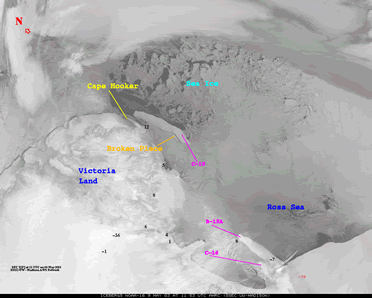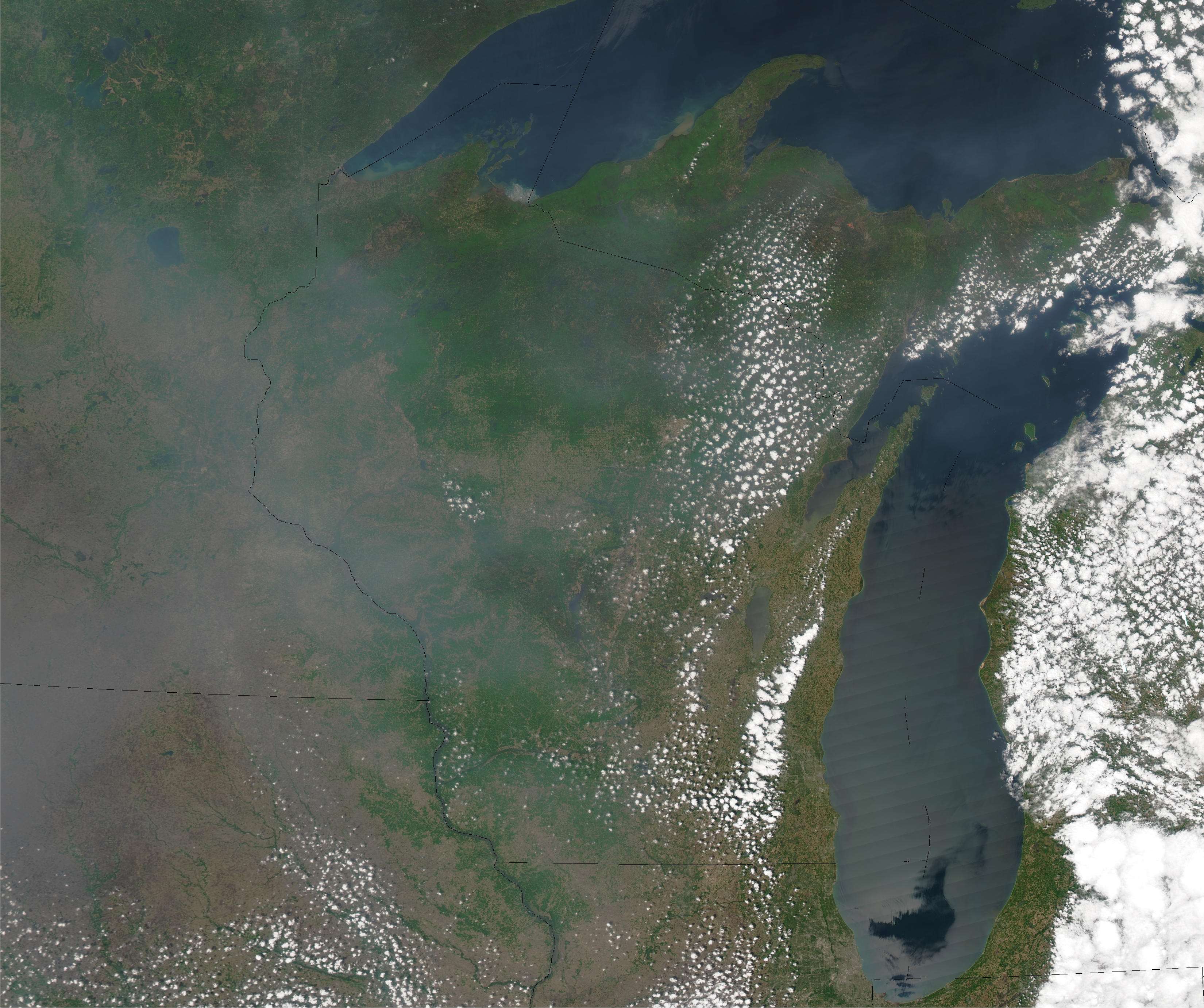Monthly News Summary – June 2003
Springtime on Neptune—Capturing the Imagination
This issue of SSEC In the News covers news and research results primarily from May 2003. Use images freely with credit to the Space Science and Engineering Center, University of Wisconsin–Madison, but please notify SSEC’s Public Information Officer. Note: Tim Schmit provided much input for May’s Top Story, GOES-8 to GOES-12, including the title.
Brightness Increases—Larry Sromovsky and other scientists used the Hubble Space Telescope to observe Neptune in 2002. Building on previous observations, they revealed significant increases in Neptune’s brightness over the years. Their analysis indicates that seasons occur on the planet and that spring has come to Neptune’s southern hemisphere. Icarus, the journal of planetary science, published their paper in volume 163, issue 1, (May 2003), pages 256–261. Besides Sromovsky, the paper’s authors are Pat Fry and Sanjay Limaye of SSEC and Kevin Baines of NASA’s Jet Propulsion Laboratory. Terry Devitt, science editor in UW–Madison’s Communications office, released the news concurrently with the Space Telescope Science Institute on 15 May, when it ran on the STScI front page. On the University News Web site, images and a movie are posted. EurekAlert!, the Web-based science news organization, and the Science Blog released Devitt’s report on 15 May. Wisconsin Week Wire published the news on 21 May.
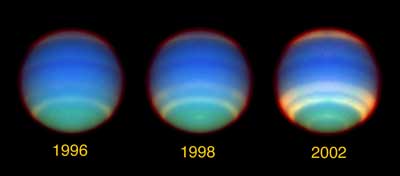 |
The thumbnails show how the brightness in Neptune’s southern hemisphere has increased since first observed in 1996 with the Hubble Space Telescope. A movieshows Neptune’s rotation and the changes over time. |
Media around the world immediately used the story. Perhaps they were cheered by news of such a far away spring. The Wisconsin State Journal’s Anita Clark featured Sromovsky on the front page, local section (May 15), and emphasized Neptune’s mysterious and puzzling nature. In “Science Times” (Tuesday, May 20), the New York Times published colored images from three years, showing the increase in brightness.USA Today (“A better Life” column, 19 May) showed an image from the brightest year in black and white, with a summary of the most interesting facts. UPI (16 May) and Aviation Week & Space Technology (2 June) also summarized the findings, and noted that the progressive brightening of Neptune’s cloud bands is “an apparent response to seasonal variations in sunlight,” although Neptune is very far from the sun.
The New Scientist’s Will Knight (15 May) noted Neptune’s extreme variations from Earth’s norm—Neptune’s axis is tilted like Earth’s, but seasons last 40 years; the average surface temperature is –218 °C; winds travel at up to 1500 km an hour. Astronomer James O’Donnell at Greenwich, England’s Royal Observatory “says the latest findings may help planetary scientists better understand how this peculiar heating process and solar radiation combine to control the surface conditions on Neptune.” The London Times on 19 May also noted that “Neptunian versions of spring, summer, autumn and winter are very different from their counterparts on Earth.”
The Milwaukee Journal Sentinel’s Susanne Quick (Sunday, 25 May) noted that the seasonal observations were based on Sromovsky’s study of Saturn’s moon, Titan. In that article, astronomer Heidi Hammel, Space Science Institute in Connecticutt, noted that Sromovsky’s conclusions differ from hypotheses by other scientists.
Ron Cohen, for Science News (24 May), also spoke with Hammel and G. Wesley Lockwood of the Lowell Observatory in Arizona. All three scientists “agree that seasonal variations may only be part of the explanation for Neptune’s remarkably dynamic atmosphere.” Hammel noted that verification of Sromovsky’s seasonal hypothesis “will send atmospheric dynamicists into a tizzy trying to explain how it could possibly be.”
Deborah Zabarenko wrote for Reuters News Service (16 May) that Neptune’s southern hemisphere spring meant “40 years of bright clouds.” She explained that, like Earth, Neptune’s axis tilts, and it is the south that is tilting toward the sun. Her release was used on 16 May by the Houston Chronicle, Yahoo!News, abc News, and Houston Public Radio. Covering the story and taking the opportunity to explain seasons wereStarrySkies.com (with a huge image of Neptune), Scientific American.com (19 May), Space.com (19 May),Astronomy.com, and MSNBC News’ Cosmic Log (16 May), in which Alan Boyle discussed the Neptunian seasonal shift and delved deeper into its mysteries. CNN.com ran the story on 17 May.
The newspaper, SpaceNews, 2 June, published the news in its column, “SpaceLog,” with outsize pictures of the planet’s southern hemisphere to show the brightness difference over time. Neptune was front page news on NASA’s Web site, 3 June. Beth Beck stressed the differences in spring on Neptune and Earth.
Basing their stories on that from University Communications were ScienceDaily (16 May); SpaceDaily,Physlink.com, and BBC News (UK Edition, 19 May); Astrobiology Magazine (28 May); and Spaceflight Now, which published large inline versions of images from the three study years, as well as a set of images showing the planet’s different faces over the years. Stories also appeared on SpaceRef (15 May), theWashington Post (Kathy Sawyer, 19 May), the Discovery Channel.com (16 May), and Ireland On-line (18 May).
Interviews were also given to reporters from Ciel et Espace (Sky and Space), the French equivalent of Sky and Telescope; and a science program on South African public radio.
Where no publishing date is noted, none was given.
Antarctica
New Iceberg—While monitoring satellite imagery of Antarctica on May 9, meteorologist Shelley Knuth in SSEC’s AMRC found that a new iceberg had splintered from C-19, one of the large tabular icebergs that had calved from the Ross Ice Shelf. She informed the National Ice Center, who called the fragment C-19B.
Data, Imagery, Software
Wisconsin MODIS image—The National Weather Service Office in Sullivan featured this image of haze over Wisconsin as Top News of the Day on 7 May. The haze appeared to be smoke from Russian fires, although a big fire did occur in northern Saskatchewan on Sunday afternoon, 4 May. However, the smoke plume from the Canadian fire was advected northeastward toward Hudson Bay. This image was received and processed at SSEC. The striping seen over Lake Michigan is an instrument artifact that is visible in bright water scenes, particularly in cases of sun glint, such as in this image.
Towards Making Satellite Data More Useful More Quickly—The NRC report to which Chris Velden contributed is now available from the National Academies Press. NASA and NOAA initially commissioned the report and have applauded the authors’ recommendations.
Rainrate Measured, Animated—Grant Petty (AOS and SSEC) and his research group developed an algorithm to retrieve rainfall from the AMSR and AMSR-E passive microwave imagers deployed on Japan’s Adeos-2 and the U.S. Aqua satellite, respectively. The algorithm was used for the first public release of microwave-derived rain rate images, based on a series of observations of Typhoon KUJIRA as it moved westward across the tropical Pacific toward Taiwan during the period 11–21 April. Using the two Advanced Microwave Scanning Radiometers together it is now possible to track the evolving rainfall patterns in a typhoon over open ocean with unprecedented continuity and detail over several days, as is clearly shown in the animation.
Earth Observatory—This popular NASA Web site has won the 2003 Webby Award, as well as a people’s choice award. Web site administrator David Herring congratulated all Earth Observatory partners, which include SSEC. The MODIS group often provides images, while Tom Whittaker and other programmers provide software tools.
Internet2—The Chronicle of Higher Education featured Internet2, * the network that “has transformed higher education” with “its ability to transmit enormous amounts of data in fractions of seconds … .” Its impact has been felt most on research and engineering articles, wrote Florence Olsen, who said that Internet2 is at a crossroads. The current economic slump may mean that the network cannot grow or become faster, which will be necessary to keep up with ever increasing research demands and just to improve how “applications work on Internet2 networks.” Or, as Ronald Trewyn, vice provost for research at Kansas State University put it, “As soon as you put in a bigger pipe, you need the next bigger one.” Pressures to upgrade, costs of doing so, and possible improvements are all discussed in the article. A few applications that use Internet2 are mentioned, including Steve Ackerman’s class, “Introduction to Weather and Climate.” Ackerman, a professor in UW–Madison’s Department of Atmospheric and Oceanic Sciences, also directs SSEC’s CIMSS.
* The article is accessible only by Chronicle subscribers.
The IHOP_2002 Newsletter, which reports on last year’s water vapor experiment, has published the article, “12 June 2002 Rapid Water Vapor Transitions during the IHOP Field Program,” by Wayne Feltz, Derek Posselt, and John Mecikalski (CIMSS) and Gary Wade and Timothy Schmit, (NOAA/NESDIS, stationed at SSEC). The article reports on an analysis of a water vapor “event,” which would not have been “detectable by surface moisture observations, and could only be resolved with high temporal remote sensing capability,” such as SSEC’s Atmospheric Emitted Radiance Interferometer.
Connecticut Woodlands—SSEC provided a GOES image to this magazine to illustrate an article on climate change. (NOAA is credited.) Writer Christine Woodside makes the case that the climate is indeed changing, using the report of the Intergovernmental) Panel on Climate Change, a regional study of New England climate and studies by other scientists.
Natural Hazards, a publication of NASA’s Web site, Earth Observatory, published a MODIS image from the Aqua satellite showing dust blowing up from Mexico into the United States. SSEC’s direct-broadcast facility provided the true-color image on April 15.
The Weather Network (Canada’s equivalent of The Weather Channel) in Toronto used animated Terra MODIS imagery of ice cover on the Great Lakes this spring. On-air meteorologist Christopher Scott used the images in an in-depth segment where high-resolution imagery highlights the science. Paraphrasing Scott Bachmeier, Scott said, “you could actually see the ice ‘move’ throughout the day.” SSEC’s CIMSS was credited.
Field Experiments and Meetings
HSR Workshop—The workshop, “Sounding from High Spectral Resolution Infrared Observations,” was held 6–8 May at the University of Wisconsin–Madison. Organized by Paolo Antonelli and Maria Vasys of CIMSS, the workshop brought together forty national and international experts. Topics ranged from radiative transfer, validation, statistical and physical retrieval methods including regression analysis, and future strategies. Henry Revercomb, SSEC director, welcomed the opportunity for people active in the field to exchange ideas from a variety of perspectives, particularly as “we enter an era of global applications for high spectral resolution from polar orbiting satellites and their advanced instruments.”
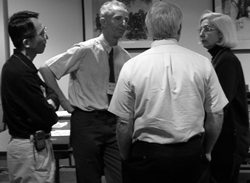 |
Allen Huang (CIMSS), Roger Saunders (Meteorology Office, UK), William L. Smith (NASA Langley Research Center), and Grace Wahba (UW–Madison, Department of Statistics) discuss radiative transfer models at the HSR workshop.This photo and those in a brief album were taken by Maciek Smuga-Otto, CIMSS. |
Besides CIMSS (SSEC’s Cooperative Institute for Meteorological Satellite Studies), researchers attended from UW–Madison’s Department of Statistics; NASA’s Langley Research Center and Goddard Space Flight Center; NOAA’s National Center for Environmental Prediction and National Environmental Satellite, Data, and Information Service; Atmospheric & Environmental Research, Inc.; Potenza, Italy’s Universita della Basilicata; Europe’s EUMETSAT; the UK’s Meteorology Office; and the University of Maryland.
Neutrino News
The National Academies’ National Research Council has published Neutrinos and Beyond: New Windows on Nature, which features IceCube and AMANDA. Published by the NRC’s Board on Physics and Astronomy, the report lucidly explains how the discovery that neutrinos have mass has “spurred proposals for new initiatives.” The report compares IceCube, the international neutrino telescope project at the South Pole led by UW–Madison, with “a new deep underground laboratory” in the U.S. The Board concludes that the two facilities are distinct. Furthermore, “IceCube is unique in its technology and location and is the most advanced project for high-energy neutrino observation on this scale.” A summary is available; the whole report is attractively priced and can be purchased on the Web.
Tropical Cyclones
A forecasting technique developed in UW–Madison’s CIMSS Tropical Cyclones group is featured inSpaceNews, 2 June 2003. Researchers have known for 30 years that air masses from the Sahara can “cause some hurricanes to weaken in defiance of computer models.” As a student working for CIMSS, hurricane forecaster Jason Dunion, now at the University of Miami assigned to NOAA’s Hurricane Research Division, developed a tracking technique using GOES infrared readings. Airplanes will collect data during this hurricane season to test the tracking technique. GOES imager data will be posted on the CIMSS Tropical Cyclones Web site throughout the test. The page links to an explanation of the technique.
Weather Experts
Radio Canada—Bob Rabin, who works with CIMSS when he is not working at Oklahoma’s National Severe Storms Laboratory, recently enlightened Canadian Radio listeners about tornadoes. He talked about the general atmospheric conditions necessary for tornado-producing storms and why they occur most frequently over the central U.S. He also discussed the relative importance of Doppler radar and storm spotter observations in tornado warnings. To read a summary in French, from the main radio page click on “Reportages Recents” in the far left frame. Then click on “Annee 2003” when it pops up, which will bring up a menu with months in it. Click on “Mai” and find “18 mai.” “La saison des tornades aux États-Unis” is under Deuxième heure about two thirds down the page.
Italian TV—Representatives of the National Italian Television science program, “Superquark,” visited Madison in April to interview Paolo Antonelli and Giulia Panegrossi, meteorologists from Italy who live and work here with their two young sons. The segment, planned for the forthcoming season, will feature the two scientists at work and home. SSEC has been promised a tape when the show airs.
Weather Guys—Steven Ackerman and Jonathan Martin shifted their normal WHA Radio appearance date to Tuesday, 27 May, because of holiday programming on 26 May. With Jim Packard hosting for Larry Meiller, they talked mostly about severe spring and summer storms, including the requisite lightning experiences—a tractor driver graphically described how he lost a finger in a thunderstorm. He was urged not to touch metal in his cab during a storm. A woman called in with her own lightning experience and was treated to a detailed explanation. Packard nudged the program toward environmental phenomena, like the length of days in Alaska and the lunar eclipse. He continued to press for lightning information, resulting in more calls about the phenomenon. The show ended with a geological question about whether Mt. Ranier would erupt soon. The Guys, being meteorologists, were unable to answer the question, but Jim promised they’d have the answer for the next show. The Weather Guys programs are archived (since February 2002) on Larry Meiller’s Wisconsin Public Radio Web pages. Search on “weather guys.” Generally, you can listen to the Weather Guys, live, on the last Monday of every month.
Weather Research
Clear Sky Products—A large part of the research mission of the Cooperative Institute for Meteorological Satellite Studies (CIMSS) at UW-Madison is developing useful products from weather satellite data and making them available for use in weather forecasts and research. With the recent move of the GOES-9 satellite to the western Pacific, Tony Schreiner (CIMSS) and Tim Schmit (NOAA) are now producing hourly Clear Sky Brightness Temperature information for Imager instruments on GOES-9, -10, and –12. These new data, along with data currently generated from GOES-10 and GOES-12, will be utilized in global forecast models at the European Centre for Medium-range Weather Forecasts (ECMWF) and the U.S. National Centers for Environmental Prediction (NCEP).
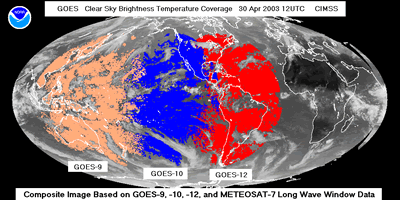 |
The figure shows how much of the earth is covered with satellite information from which clear-sky temperature measurements are obtained. |
Data from the GOES-9 Sounder instrument is being received over the western Pacific and is being archived. A sample loop of the GOES-9 Sounder data is available.
Special GOES Movie—On May 19, Rick Anthes, University Corporation for Atmospheric Research, spoke to Congressional staffers from the Senate Committee on Commerce, Science and Transportation and the House Committee on Science. To show the need for high spatial resolution images, Tim Schmit (NOAA, at SSEC) and Tom Whittaker (CIMSS) provided data loops showing progressive averaging for GOES Imager infrared images.
GOES-9 on Duty—On May 22, GOES-9 replaced Japan’s Geostationary Meteorological Satellite (GMS) at 155 East longitude. A variety of products and procedures were put in place for GOES-9. Gary Wade (NOAA, at SSEC) made available all GOES-9 Sounder bands in near-real time as day-long animations on the CIMSS Web page. The hourly schedule for the GOES-9 Sounder provides for three sectors, with coverage for the central (including Papua New Guinea) and southern (including eastern Australia) available every six hours while northern (including Japan) coverage is available for the remaining 16 hours. Sounder derived products, such as total precipitable water, are now being produced with broad coverage in the mid latitudes over the Pacific Ocean and U.S. Real-time GOES-9 (formerly GMS), GOES-10 (-West), and GOES-12 (-East) imagery and products are displayed on the CIMSS Web page. Sector scheduling among the three GOES satellites provides for optimal coverage over this wide area for only 12 out of 24 hours, although U.S. coverage remains hourly.
With NOAA’s Forecast Products Development Team, the CIMSS Winds Team developed and helped implement new winds code that utilizes GOES-9 imagery for wind measurements tracked in cloud features. The transition into operational winds production at both NESDIS and the Air Force Weather Agency went smoothly and routine datasets are now being produced and disseminated to users.
The CIMSS GOES sounder team of Jim Nelson and Tony Schreiner (CIMSS) and Gary Wade and Tim Schmit (NOAA) is producing GOES-9 vertical profiles of temperature and moisture from Sounder information over the western Pacific Ocean. They are also generating Derived Product Images (DPI) of Lifted Index (LI), Total Precipitable Water (TPW) vapor and surface skin temperature.
Papers, Presentations
Where SSEC staff or students are first through third authors, or, if not, the contributions are substantial.
“Cloud-drift and Water Vapor Winds in the Polar Regions from MODIS” was published in IEEE Transactions on Geoscience and Remote Sensing for a special issue on the Aqua satellite (2003, vol. 41, number 2). Authors are Jeff Key (NOAA, at SSEC), Dave Santek (CIMSS), Chris Velden (CIMSS), N. Bormann (European Centre for Medium-Range Weather Forecasts, ECMWF), J.-N. Thepaut (ECMWF), L.P. Riishojgaard (Data Assimilation Office, DAO), Y. Zhu (DAO), and W. Paul Menzel (NOAA, ORA, at SSEC). The paper describes how wind information can be obtained from polar-orbiting imagers, specifically the Moderate Resolution Imaging Spectroradiometer (MODIS), and provides results from model impact studies at ECMWF and DAO.
John Mecikalski (CIMSS) and Gregory Tripoli (Dept. of Atmospheric and Oceanic Sciences), wrote “Influence of Upper-Tropospheric Inertial Stability on the Convective Transport of Momentum” for theQuarterly Journal of the Royal Meteorological Society, volume 129, number 590, 2003.
John Mecikalski, “A Method for Estimating Momentum Fluxes of Deep Precipitating Convection Using Profiling Doppler Radar,” Journal of Geophysical Research, vol. 108, no. D56, 2003.
Wayne Feltz, William L. Smith, Ben Howell, Robert Knuteson, Hal Woolf, and Henry Revercomb, “Near Continuous Profiling of Temperature, Moisture, and Atmospheric Stability using the Atmospheric Emitted Radiance Interferometer (AERI),” Journal of Applied Meteorology, vol. 2, no.5, 2003.
“Detection and analysis of clear sky, low-level atmospheric temperature inversions with MODIS,” by Yinghui Liu and Jeff Key, was accepted for publication in the Journal of Atmospheric and Oceanic Technology.The paper presents a method for estimating low-level atmospheric temperature inversion strength, defined as the temperature difference across the inversion, and height using the Moderate Resolution Imaging Spectroradiometer (MODIS). Inversion strength can be estimated with an uncertainty of 2-3 degrees C; the uncertainty in inversion height is 130-250 meters.
Chris Velden; Joanne Simpson, Timothy Liu, J. Hawkins, Kurt Brueske, and Richard Anthes, wrote “The Burgeoning Role of Weather Satellites,” published in Hurricane! Coping with Disaster: Progress and Challenges since Galveston, 1900 by the American Geophysical Union in 2003. Velden and Brueske contributed to other chapters in this book.
Ping Yang, Bryan A. Baum, Andrew J. Heymsfield, Yong X. Hu, Allen Huang, Si-Chee Tsay, and Steve Ackerman wrote “Single-scattering Properties of Droxtals,” published in the Journal of Quantitative Spectroscopy and Radiative Transfer, vol. 79-80, 2003.
Those same authors with He-Li Wei, Bo-Cai Gao, David D. Turner and without Si-Chee Tsay also wrote “The spectral signature of mixed-phase clouds composed of non-spherical ice crystals and spherical liquid droplets in the terrestrial window region” for the same issue.
Education, Outreach
PEOPLE Progress—UW–Madison’s PEOPLE Program for 2003 started Monday, June 9th, and students participating in the “Aviation and Space” workshop were thrilled with the first day of their summer experience. Michael Mcardle, a hot air balloonist and retired Madison East High School teacher, offered tethered balloon rides to 14 middle school students in Quann Park, close to UW Space Place, where the rest of the workshop is held.
PEOPLE (Pre-college Enrichment Opportunity Program for Learning Excellence) seeks to increase college enrollment and graduation of ethnic minority students by reaching out to them in middle and high school. SSEC’s Office of Space Science Education has participated in the PEOPLE program since it began in the summer of 2000. The Space Exploration workshop added the Aviation component through a collaboration with the Wisconsin Department of Transportation with Karen Valley’s help. This has added a fun-filled week of aviation experiences, including a trip to the EAA in Oshkosh. This workshop continues to offer interesting and challenging lessons on space travel, the solar system and rockets. This year, to mark the launch of three spacecraft towards Mars this month and the close approach of the Red Planet to Earth in August, the workshop will feature Mars Exploration.
Honors
AOS Student Awards—Graduate students working with CIMSS scientists received awards in their home Department, Atmospheric and Oceanic Sciences (AOS). Robert Wacker received the department’s Schwerdtfeger Award for excellent performance in first year graduate studies. Gregory Gallina received the Lettau Award for outstanding MS Thesis. Awards were presented at the department’s awards day, April 30. Both students work with Chris Velden, the scientist who leads CIMSS work in tropical cyclones and winds measurements. CIMSS supports the research of several graduate students in AOS.
Thanks to all who provided links and information for this issue, including Cheryl Gundy (STScI); Linda Hedges, Chris Schmidt, Erik Olson, Suzanne Wetzel-Seemann, Maria Vasys, and Chris Velden (SSEC); and Elaine Prins and Tim Schmit (NOAA, working with CIMSS).

